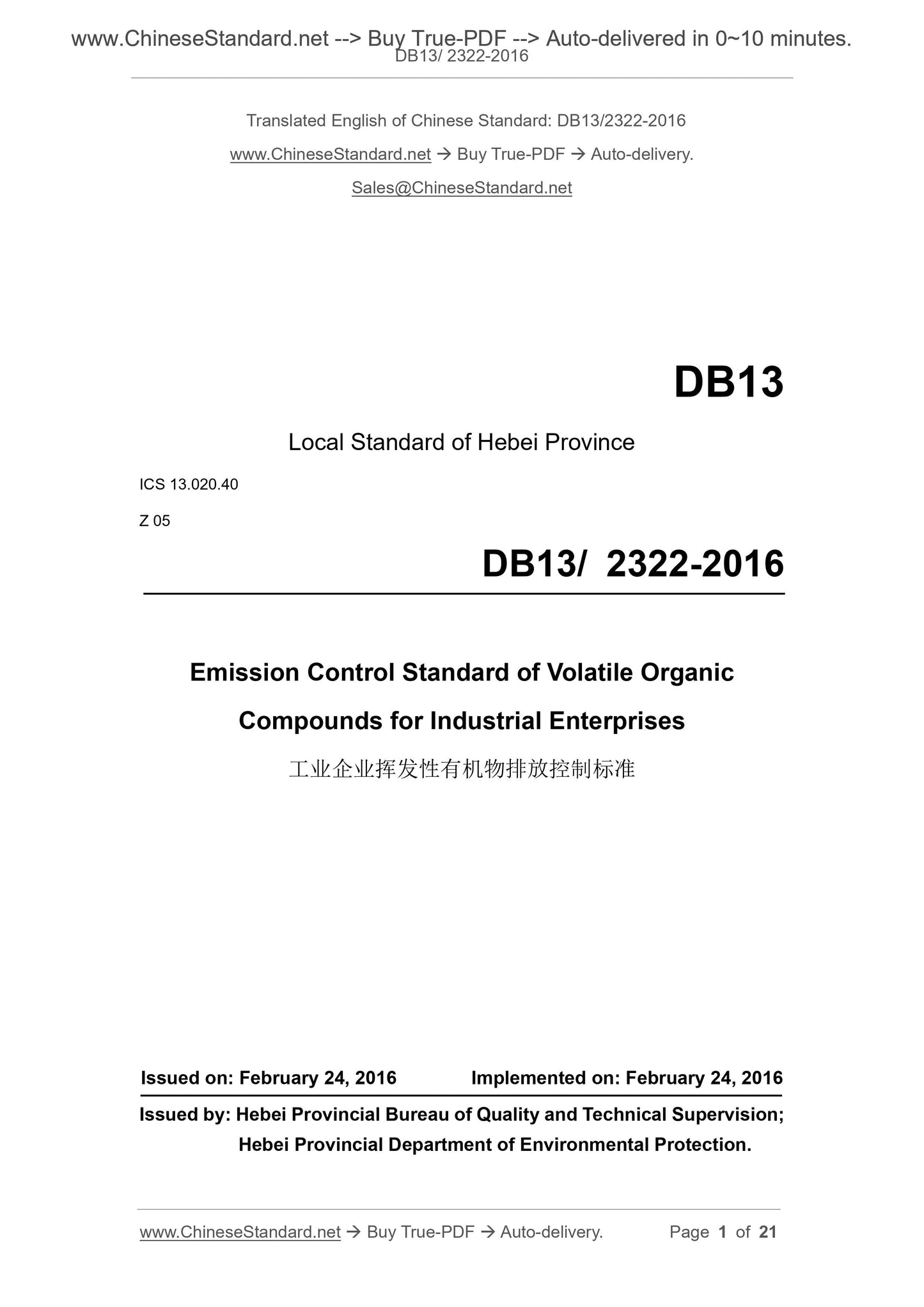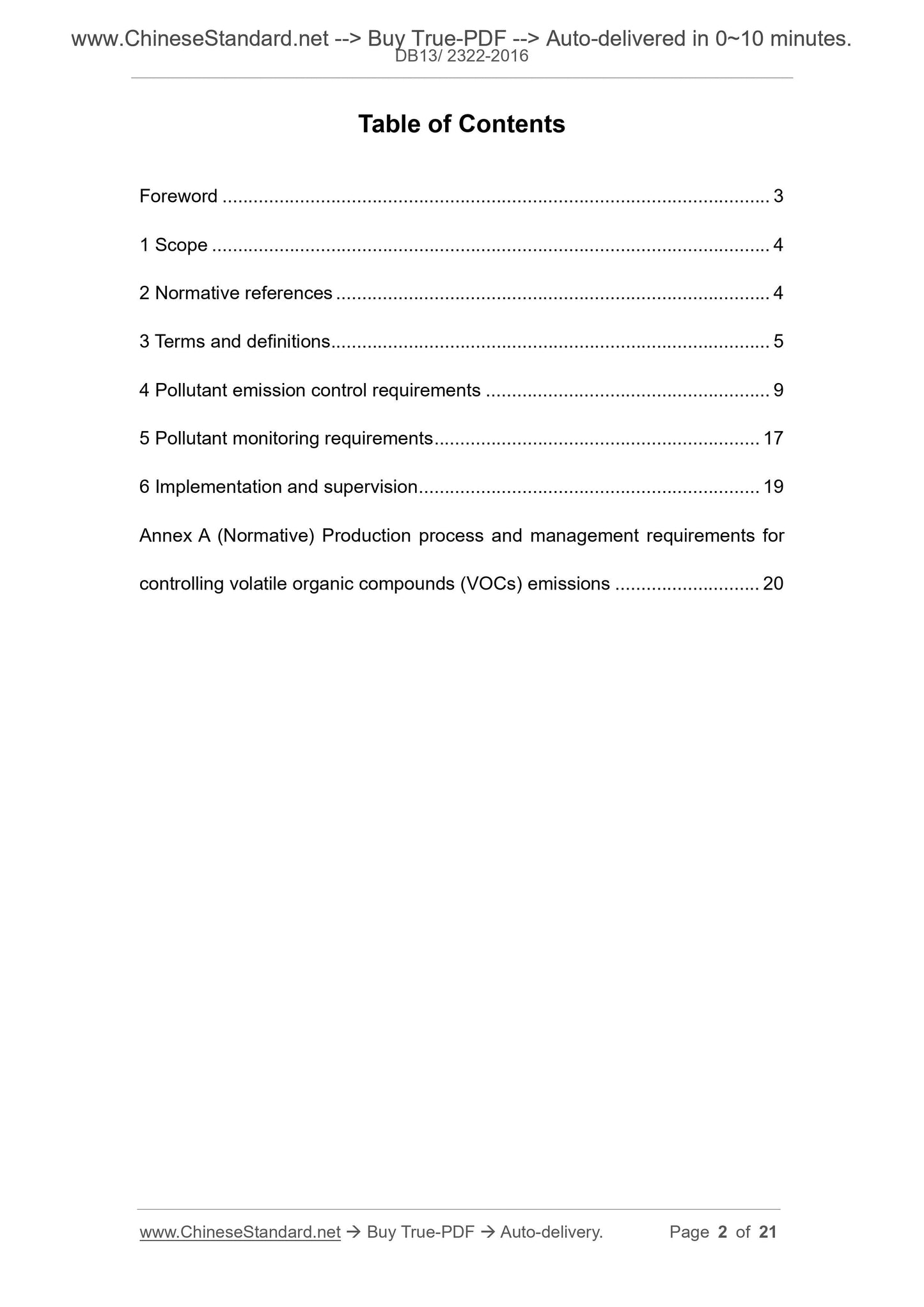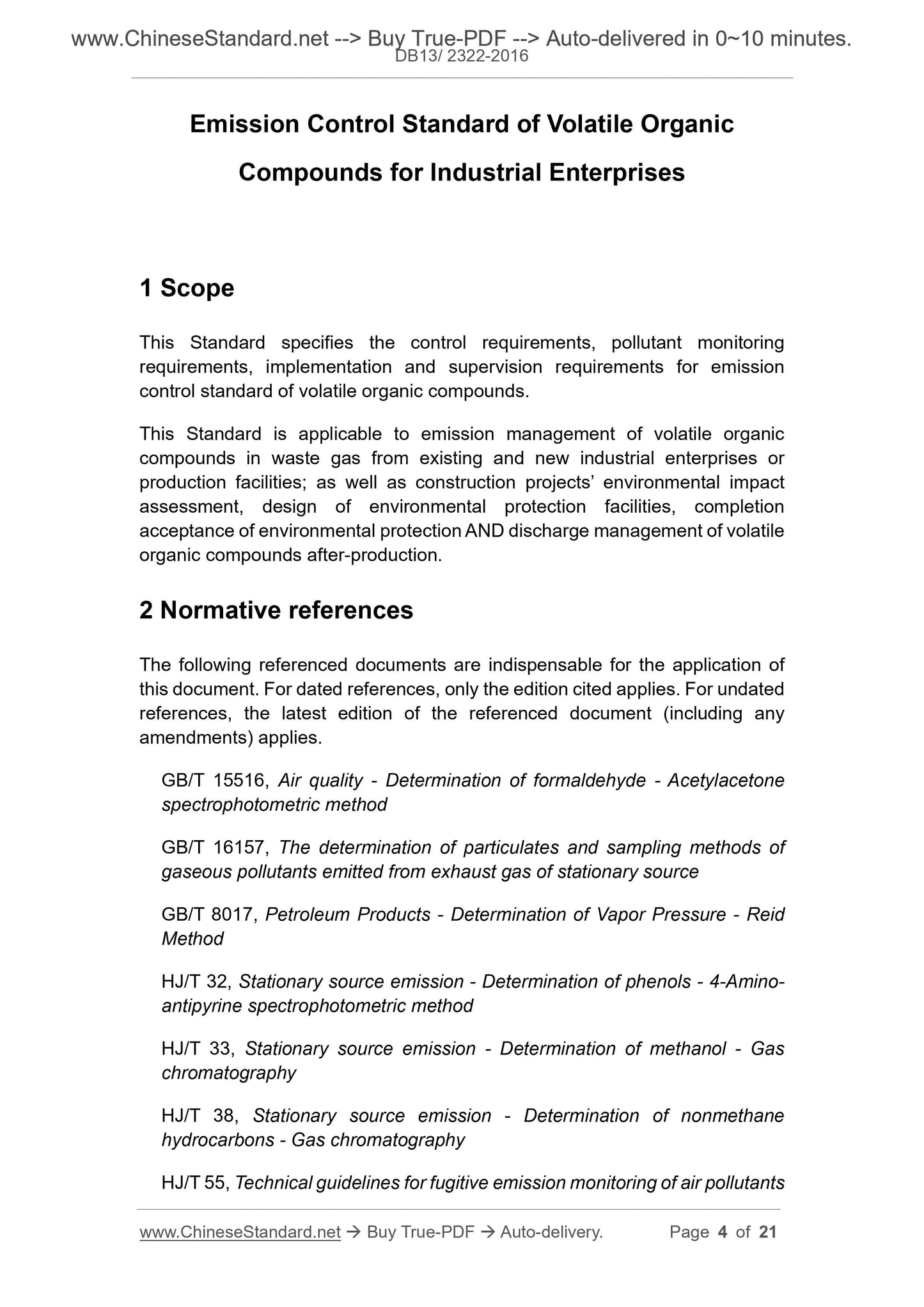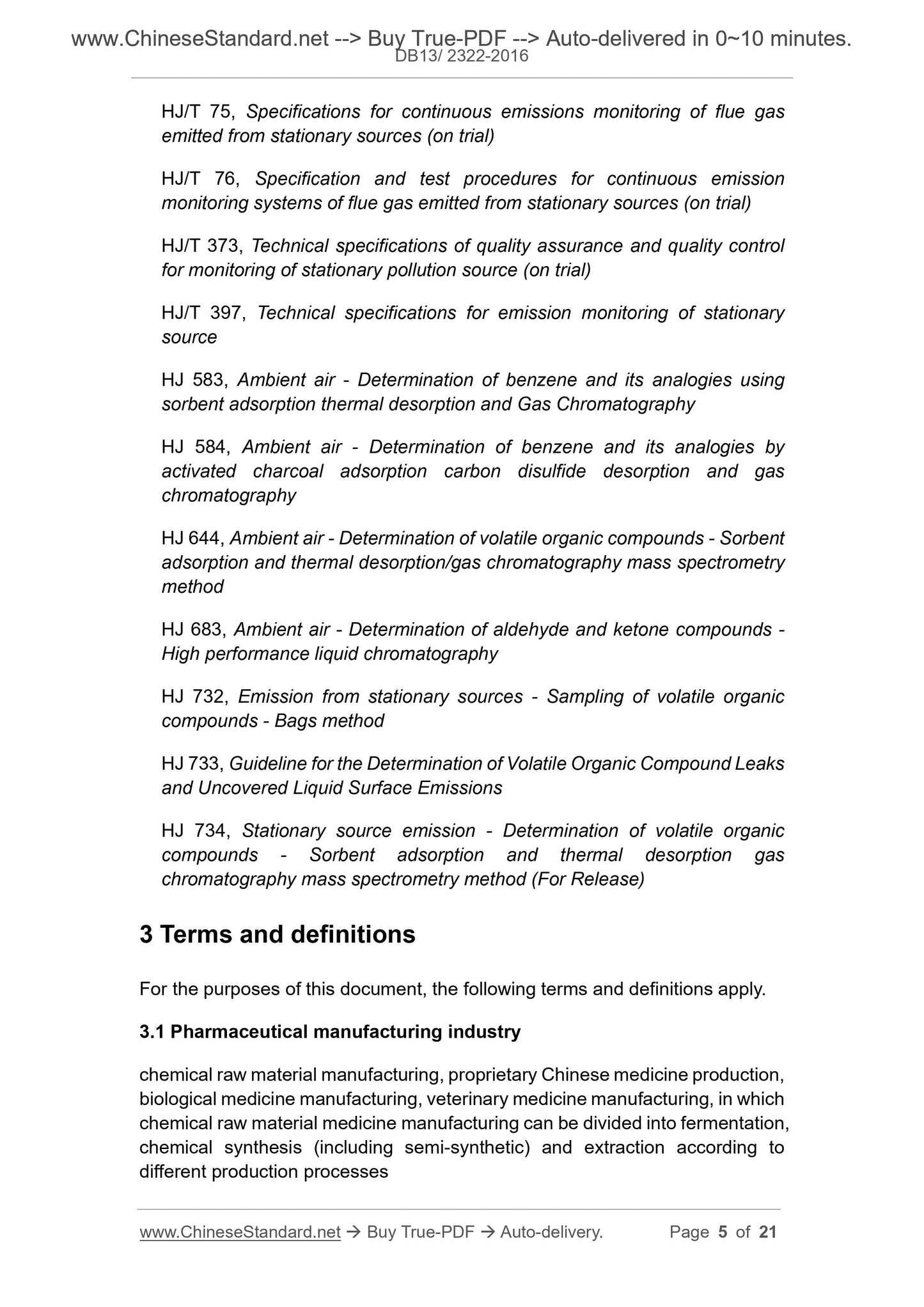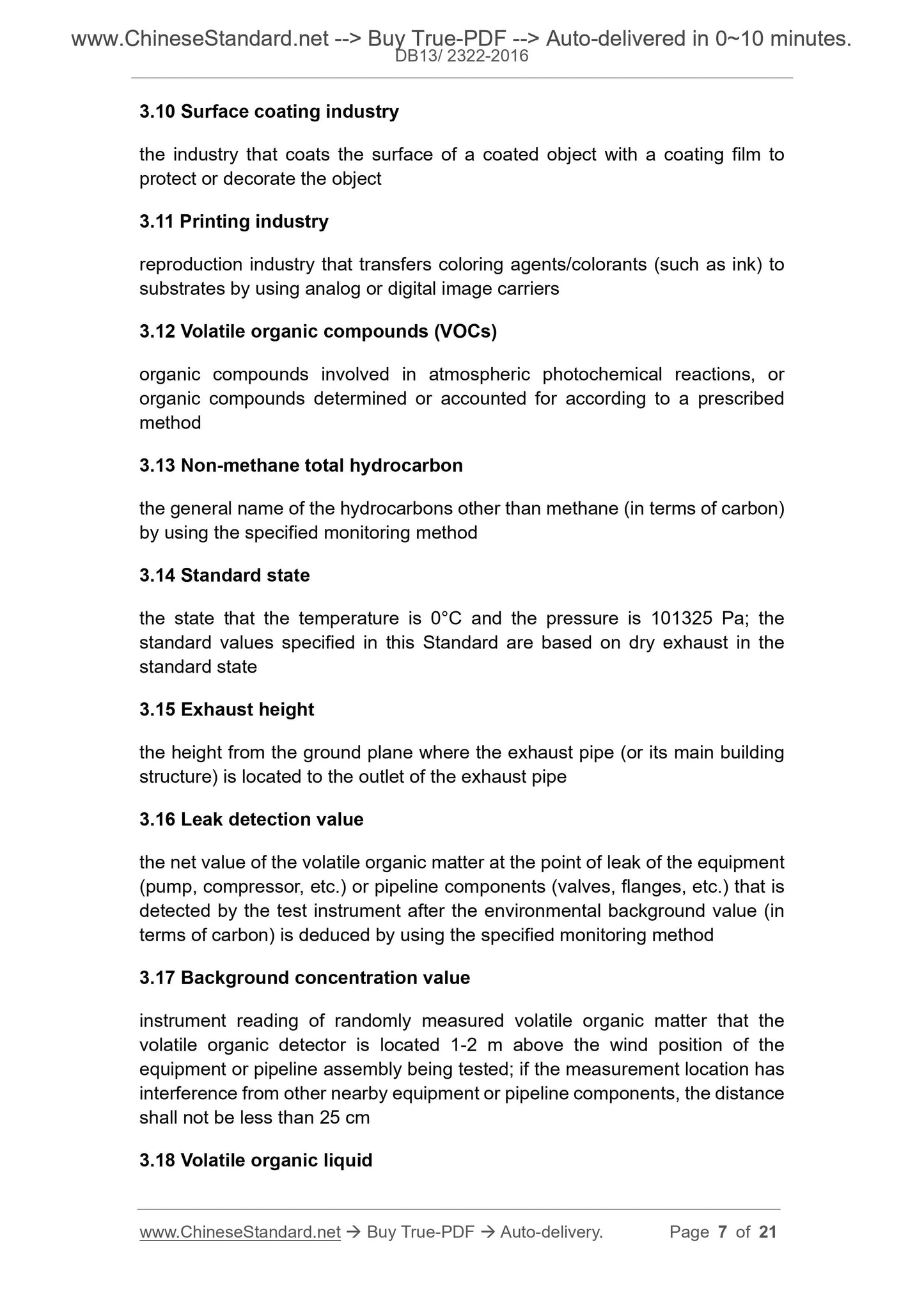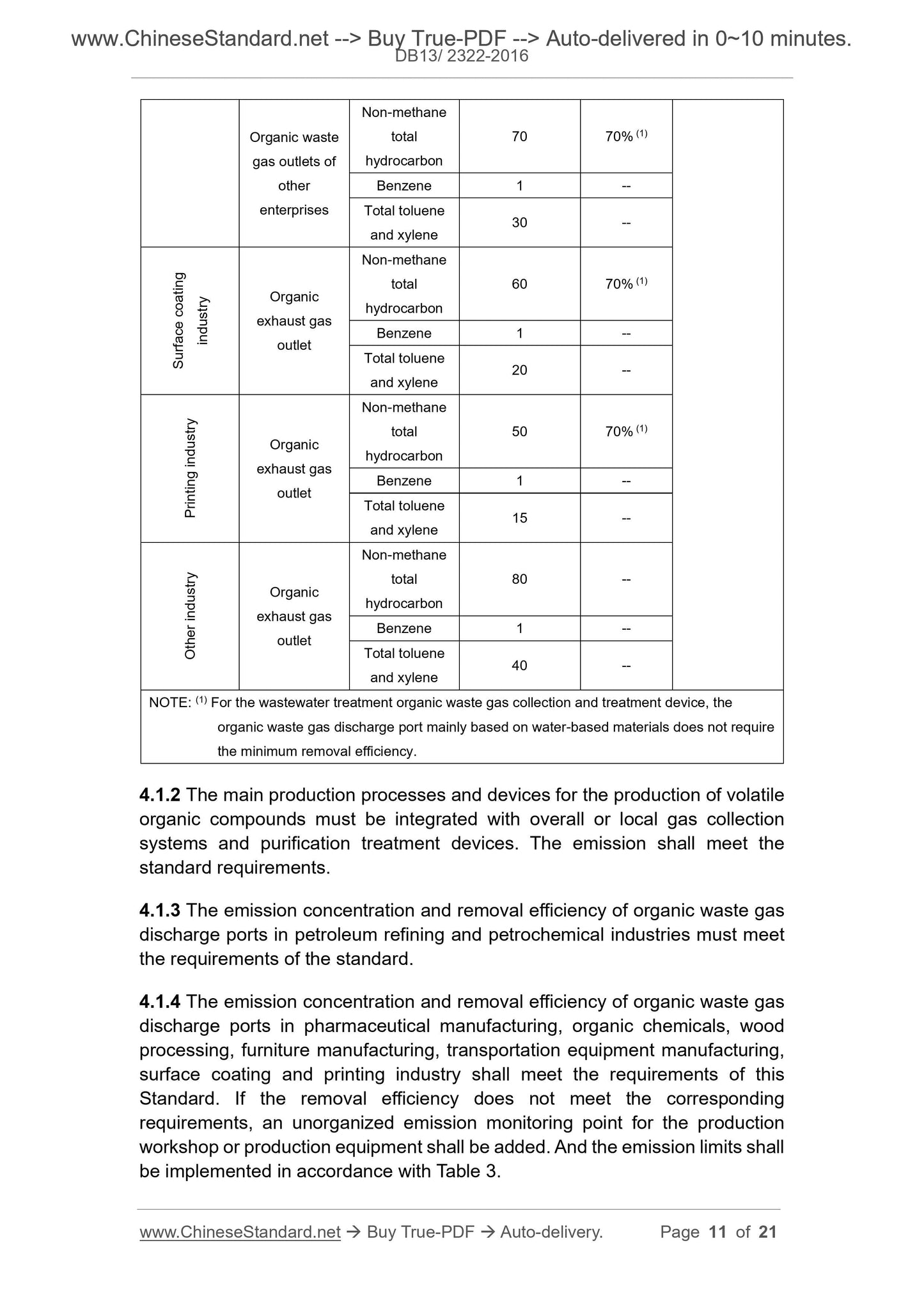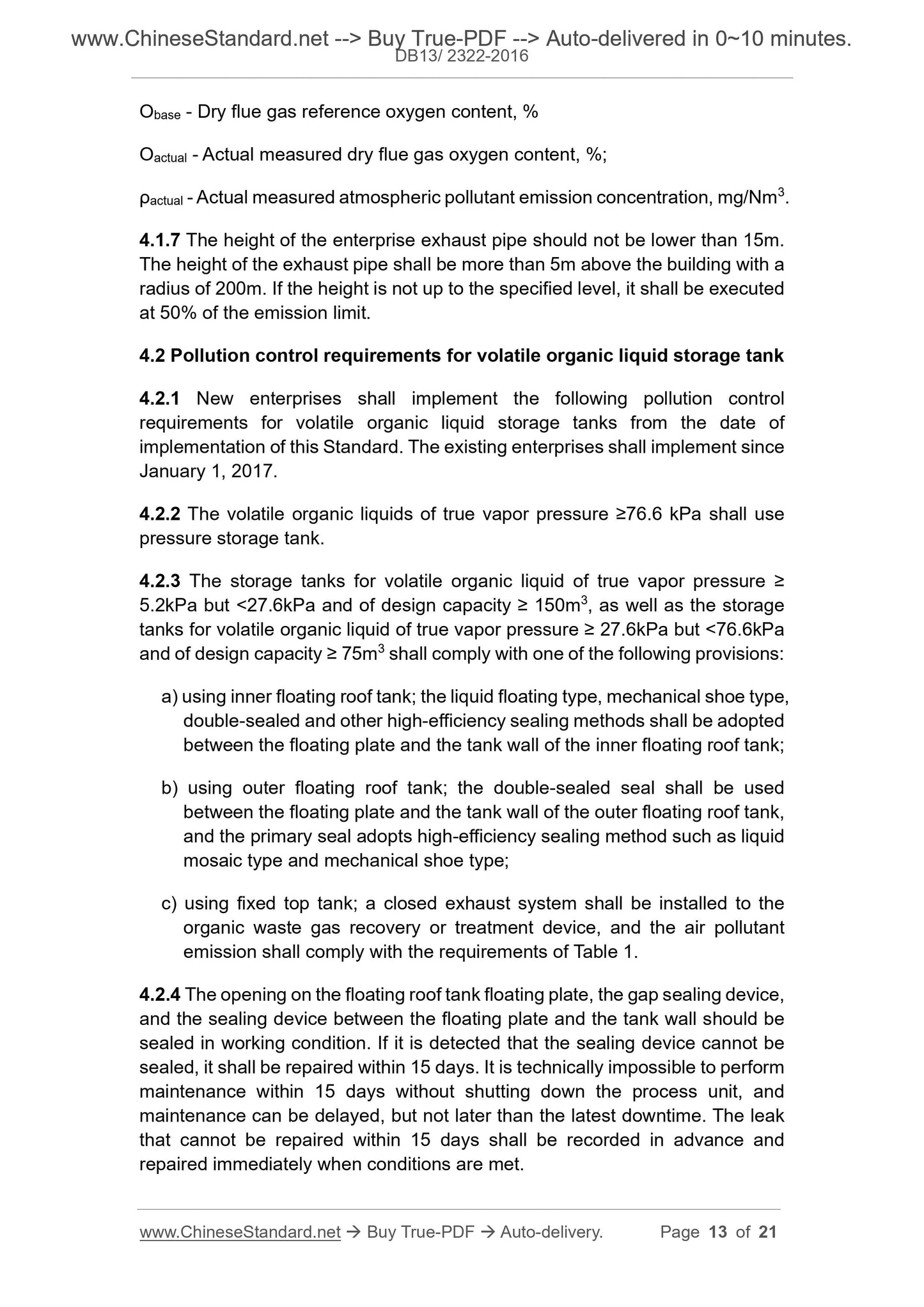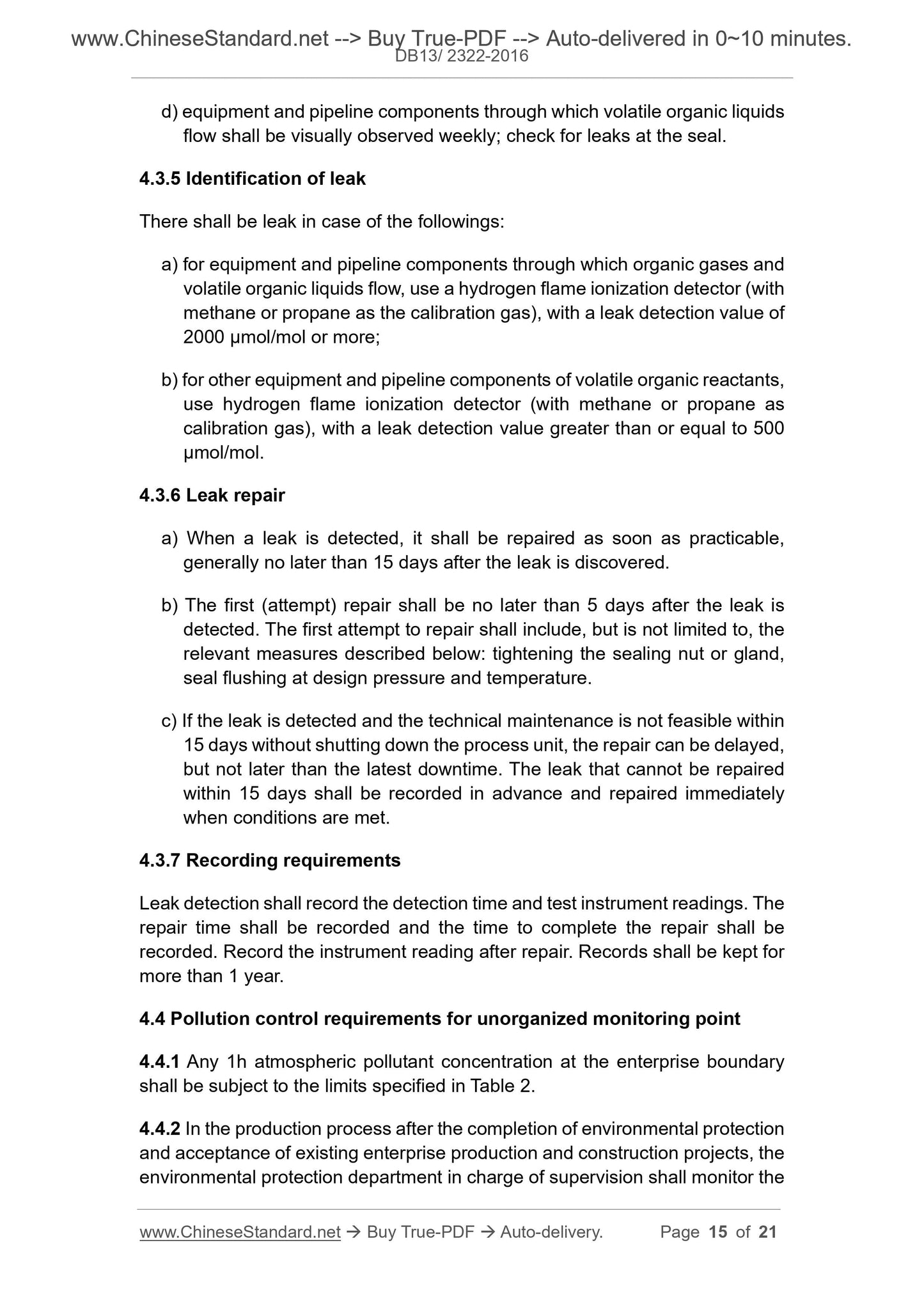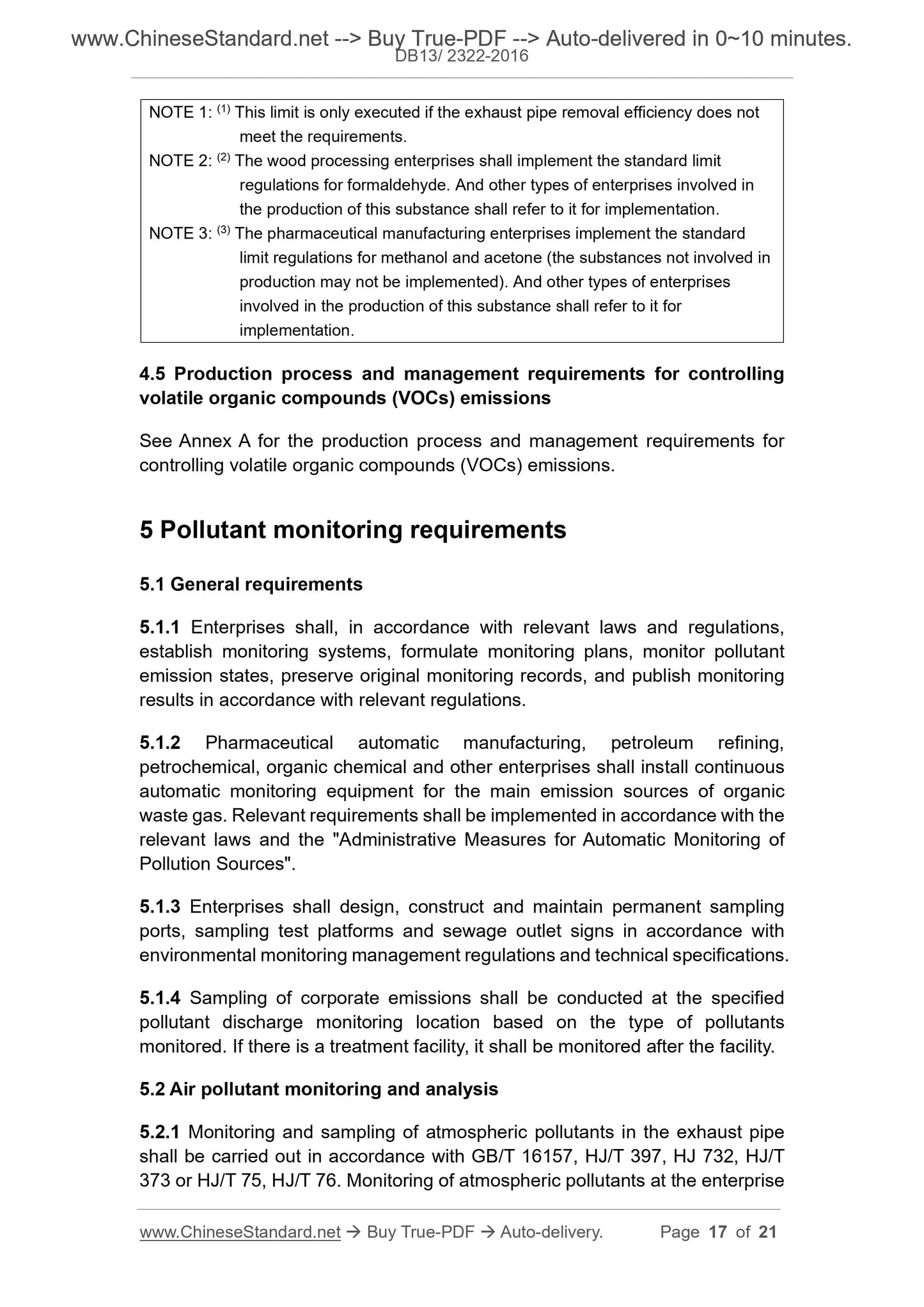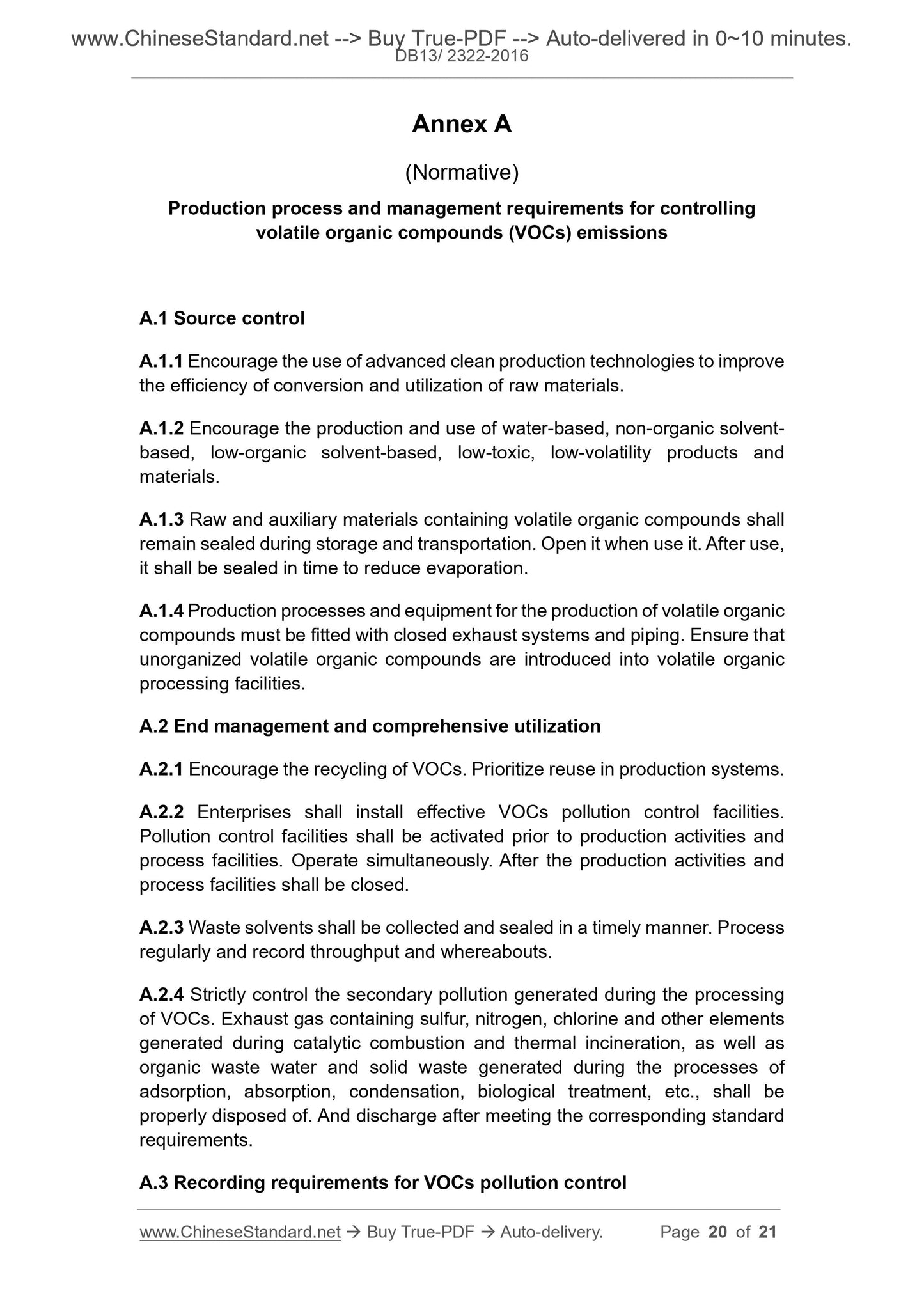1
/
of
10
PayPal, credit cards. Download editable-PDF & invoice In 1 second!
DB13/ 2322-2016 English PDF (DB132322-2016)
DB13/ 2322-2016 English PDF (DB132322-2016)
Regular price
$445.00 USD
Regular price
Sale price
$445.00 USD
Unit price
/
per
Shipping calculated at checkout.
Couldn't load pickup availability
Delivery: 3 seconds. Download true-PDF + Invoice.
Get QUOTATION in 1-minute: Click DB13/ 2322-2016
Historical versions: DB13/ 2322-2016
Preview True-PDF (Reload/Scroll if blank)
DB13/ 2322-2016: Emission Control Standard of Volatile Organic Compounds for Industrial Enterprises
DB13/ 2322-2016
DB13
Local Standard of Hebei Province
ICS 13.020.40
Z 05
Emission Control Standard of Volatile Organic
Compounds for Industrial Enterprises
ISSUED ON: FEBRUARY 24, 2016
IMPLEMENTED ON: FEBRUARY 24, 2016
Issued by: Hebei Provincial Bureau of Quality and Technical Supervision;
Hebei Provincial Department of Environmental Protection.
Table of Contents
Foreword ... 3
1 Scope ... 4
2 Normative references ... 4
3 Terms and definitions ... 5
4 Pollutant emission control requirements ... 9
5 Pollutant monitoring requirements ... 17
6 Implementation and supervision ... 19
Annex A (Normative) Production process and management requirements for
controlling volatile organic compounds (VOCs) emissions ... 20
Emission Control Standard of Volatile Organic
Compounds for Industrial Enterprises
1 Scope
This Standard specifies the control requirements, pollutant monitoring
requirements, implementation and supervision requirements for emission
control standard of volatile organic compounds.
This Standard is applicable to emission management of volatile organic
compounds in waste gas from existing and new industrial enterprises or
production facilities; as well as construction projects’ environmental impact
assessment, design of environmental protection facilities, completion
acceptance of environmental protection AND discharge management of volatile
organic compounds after-production.
2 Normative references
The following referenced documents are indispensable for the application of
this document. For dated references, only the edition cited applies. For undated
references, the latest edition of the referenced document (including any
amendments) applies.
GB/T 15516, Air quality - Determination of formaldehyde - Acetylacetone
spectrophotometric method
GB/T 16157, The determination of particulates and sampling methods of
gaseous pollutants emitted from exhaust gas of stationary source
GB/T 8017, Petroleum Products - Determination of Vapor Pressure - Reid
Method
HJ/T 32, Stationary source emission - Determination of phenols - 4-Amino-
antipyrine spectrophotometric method
HJ/T 33, Stationary source emission - Determination of methanol - Gas
chromatography
HJ/T 38, Stationary source emission - Determination of nonmethane
hydrocarbons - Gas chromatography
HJ/T 55, Technical guidelines for fugitive emission monitoring of air pollutants
HJ/T 75, Specifications for continuous emissions monitoring of flue gas
emitted from stationary sources (on trial)
HJ/T 76, Specification and test procedures for continuous emission
monitoring systems of flue gas emitted from stationary sources (on trial)
HJ/T 373, Technical specifications of quality assurance and quality control
for monitoring of stationary pollution source (on trial)
HJ/T 397, Technical specifications for emission monitoring of stationary
source
HJ 583, Ambient air - Determination of benzene and its analogies using
sorbent adsorption thermal desorption and Gas Chromatography
HJ 584, Ambient air - Determination of benzene and its analogies by
activated charcoal adsorption carbon disulfide desorption and gas
chromatography
HJ 644, Ambient air - Determination of volatile organic compounds - Sorbent
adsorption and thermal desorption/gas chromatography mass spectrometry
method
HJ 683, Ambient air - Determination of aldehyde and ketone compounds -
High performance liquid chromatography
HJ 732, Emission from stationary sources - Sampling of volatile organic
compounds - Bags method
HJ 733, Guideline for the Determination of Volatile Organic Compound Leaks
and Uncovered Liquid Surface Emissions
HJ 734, Stationary source emission - Determination of volatile organic
compounds - Sorbent adsorption and thermal desorption gas
chromatography mass spectrometry method (For Release)
3 Terms and definitions
For the purposes of this document, the following terms and definitions apply.
3.1 Pharmaceutical manufacturing industry
chemical raw material manufacturing, proprietary Chinese medicine production,
biological medicine manufacturing, veterinary medicine manufacturing, in which
chemical raw material medicine manufacturing can be divided into fermentation,
chemical synthesis (including semi-synthetic) and extraction according to
different production processes
3.10 Surface coating industry
the industry that coats the surface of a coated object with a coating film to
protect or decorate the object
3.11 Printing industry
reproduction industry that transfers coloring agents/colorants (such as ink) to
substrates by using analog or digital image carriers
3.12 Volatile organic compounds (VOCs)
organic compounds involved in atmospheric photochemical reactions, or
organic compounds determined or accounted for according to a prescribed
method
3.13 Non-methane total hydrocarbon
the general name of the hydrocarbons other than methane (in terms of carbon)
by using the specified monitoring method
3.14 Standard state
the state that the temperature is 0°C and the pressure is 101325 Pa; the
standard values specified in this Standard are based on dry exhaust in the
standard state
3.15 Exhaust height
the height from the ground plane where the exhaust pipe (or its main building
structure) is located to the outlet of the exhaust pipe
3.16 Leak detection value
the net value of the volatile organic matter at the point of leak of the equipment
(pump, compressor, etc.) or pipeline components (valves, flanges, etc.) that is
detected by the test instrument after the environmental background value (in
terms of carbon) is deduced by using the specified monitoring method
3.17 Background concentration value
instrument reading of randomly measured volatile organic matter that the
volatile organic detector is located 1-2 m above the wind position of the
equipment or pipeline assembly being tested; if the measurement location has
interference from other nearby equipment or pipeline components, the distance
shall not be less than 25 cm
3.18 Volatile organic liquid
Organic waste
gas outlets of
other
enterprises
Non-methane
total
hydrocarbon
70 70% (1)
Benzene 1 --
Total toluene
and xylene 30 --
Su
rfa
ce
co
ati
ng
ind
us
try
Organic
exhaust gas
outlet
Non-methane
total
hydrocarbon
60 70% (1)
Benzene 1 --
Total toluene
and xylene 20 --
Pri
nti
ng
in
du
str
Organic
exhaust gas
outlet
Non-methane
total
hydrocarbon
50 70% (1)
Benzene 1 --
Total toluene
and xylene 15 --
Ot
he
r in
du
str
Organic
exhaust gas
outlet
Non-methane
total
hydrocarbon
80 --
Benzene 1 --
Total toluene
and xylene 40 --
NOTE: (1) For the wastewater treatment organic waste gas collection and treatment device, the
organic waste gas discharge port mainly based on water-based materials does not require
the minimum removal efficiency.
4.1.2 The main production processes and devices for the production of volatile
organic compounds must be integrated with overall or local gas collection
systems and purification treatment devices. The emission shall meet the
standard requirements.
4.1.3 The emission concentration and removal efficiency of organic waste gas
discharge ports in petroleum refin...
Get QUOTATION in 1-minute: Click DB13/ 2322-2016
Historical versions: DB13/ 2322-2016
Preview True-PDF (Reload/Scroll if blank)
DB13/ 2322-2016: Emission Control Standard of Volatile Organic Compounds for Industrial Enterprises
DB13/ 2322-2016
DB13
Local Standard of Hebei Province
ICS 13.020.40
Z 05
Emission Control Standard of Volatile Organic
Compounds for Industrial Enterprises
ISSUED ON: FEBRUARY 24, 2016
IMPLEMENTED ON: FEBRUARY 24, 2016
Issued by: Hebei Provincial Bureau of Quality and Technical Supervision;
Hebei Provincial Department of Environmental Protection.
Table of Contents
Foreword ... 3
1 Scope ... 4
2 Normative references ... 4
3 Terms and definitions ... 5
4 Pollutant emission control requirements ... 9
5 Pollutant monitoring requirements ... 17
6 Implementation and supervision ... 19
Annex A (Normative) Production process and management requirements for
controlling volatile organic compounds (VOCs) emissions ... 20
Emission Control Standard of Volatile Organic
Compounds for Industrial Enterprises
1 Scope
This Standard specifies the control requirements, pollutant monitoring
requirements, implementation and supervision requirements for emission
control standard of volatile organic compounds.
This Standard is applicable to emission management of volatile organic
compounds in waste gas from existing and new industrial enterprises or
production facilities; as well as construction projects’ environmental impact
assessment, design of environmental protection facilities, completion
acceptance of environmental protection AND discharge management of volatile
organic compounds after-production.
2 Normative references
The following referenced documents are indispensable for the application of
this document. For dated references, only the edition cited applies. For undated
references, the latest edition of the referenced document (including any
amendments) applies.
GB/T 15516, Air quality - Determination of formaldehyde - Acetylacetone
spectrophotometric method
GB/T 16157, The determination of particulates and sampling methods of
gaseous pollutants emitted from exhaust gas of stationary source
GB/T 8017, Petroleum Products - Determination of Vapor Pressure - Reid
Method
HJ/T 32, Stationary source emission - Determination of phenols - 4-Amino-
antipyrine spectrophotometric method
HJ/T 33, Stationary source emission - Determination of methanol - Gas
chromatography
HJ/T 38, Stationary source emission - Determination of nonmethane
hydrocarbons - Gas chromatography
HJ/T 55, Technical guidelines for fugitive emission monitoring of air pollutants
HJ/T 75, Specifications for continuous emissions monitoring of flue gas
emitted from stationary sources (on trial)
HJ/T 76, Specification and test procedures for continuous emission
monitoring systems of flue gas emitted from stationary sources (on trial)
HJ/T 373, Technical specifications of quality assurance and quality control
for monitoring of stationary pollution source (on trial)
HJ/T 397, Technical specifications for emission monitoring of stationary
source
HJ 583, Ambient air - Determination of benzene and its analogies using
sorbent adsorption thermal desorption and Gas Chromatography
HJ 584, Ambient air - Determination of benzene and its analogies by
activated charcoal adsorption carbon disulfide desorption and gas
chromatography
HJ 644, Ambient air - Determination of volatile organic compounds - Sorbent
adsorption and thermal desorption/gas chromatography mass spectrometry
method
HJ 683, Ambient air - Determination of aldehyde and ketone compounds -
High performance liquid chromatography
HJ 732, Emission from stationary sources - Sampling of volatile organic
compounds - Bags method
HJ 733, Guideline for the Determination of Volatile Organic Compound Leaks
and Uncovered Liquid Surface Emissions
HJ 734, Stationary source emission - Determination of volatile organic
compounds - Sorbent adsorption and thermal desorption gas
chromatography mass spectrometry method (For Release)
3 Terms and definitions
For the purposes of this document, the following terms and definitions apply.
3.1 Pharmaceutical manufacturing industry
chemical raw material manufacturing, proprietary Chinese medicine production,
biological medicine manufacturing, veterinary medicine manufacturing, in which
chemical raw material medicine manufacturing can be divided into fermentation,
chemical synthesis (including semi-synthetic) and extraction according to
different production processes
3.10 Surface coating industry
the industry that coats the surface of a coated object with a coating film to
protect or decorate the object
3.11 Printing industry
reproduction industry that transfers coloring agents/colorants (such as ink) to
substrates by using analog or digital image carriers
3.12 Volatile organic compounds (VOCs)
organic compounds involved in atmospheric photochemical reactions, or
organic compounds determined or accounted for according to a prescribed
method
3.13 Non-methane total hydrocarbon
the general name of the hydrocarbons other than methane (in terms of carbon)
by using the specified monitoring method
3.14 Standard state
the state that the temperature is 0°C and the pressure is 101325 Pa; the
standard values specified in this Standard are based on dry exhaust in the
standard state
3.15 Exhaust height
the height from the ground plane where the exhaust pipe (or its main building
structure) is located to the outlet of the exhaust pipe
3.16 Leak detection value
the net value of the volatile organic matter at the point of leak of the equipment
(pump, compressor, etc.) or pipeline components (valves, flanges, etc.) that is
detected by the test instrument after the environmental background value (in
terms of carbon) is deduced by using the specified monitoring method
3.17 Background concentration value
instrument reading of randomly measured volatile organic matter that the
volatile organic detector is located 1-2 m above the wind position of the
equipment or pipeline assembly being tested; if the measurement location has
interference from other nearby equipment or pipeline components, the distance
shall not be less than 25 cm
3.18 Volatile organic liquid
Organic waste
gas outlets of
other
enterprises
Non-methane
total
hydrocarbon
70 70% (1)
Benzene 1 --
Total toluene
and xylene 30 --
Su
rfa
ce
co
ati
ng
ind
us
try
Organic
exhaust gas
outlet
Non-methane
total
hydrocarbon
60 70% (1)
Benzene 1 --
Total toluene
and xylene 20 --
Pri
nti
ng
in
du
str
Organic
exhaust gas
outlet
Non-methane
total
hydrocarbon
50 70% (1)
Benzene 1 --
Total toluene
and xylene 15 --
Ot
he
r in
du
str
Organic
exhaust gas
outlet
Non-methane
total
hydrocarbon
80 --
Benzene 1 --
Total toluene
and xylene 40 --
NOTE: (1) For the wastewater treatment organic waste gas collection and treatment device, the
organic waste gas discharge port mainly based on water-based materials does not require
the minimum removal efficiency.
4.1.2 The main production processes and devices for the production of volatile
organic compounds must be integrated with overall or local gas collection
systems and purification treatment devices. The emission shall meet the
standard requirements.
4.1.3 The emission concentration and removal efficiency of organic waste gas
discharge ports in petroleum refin...
Share
